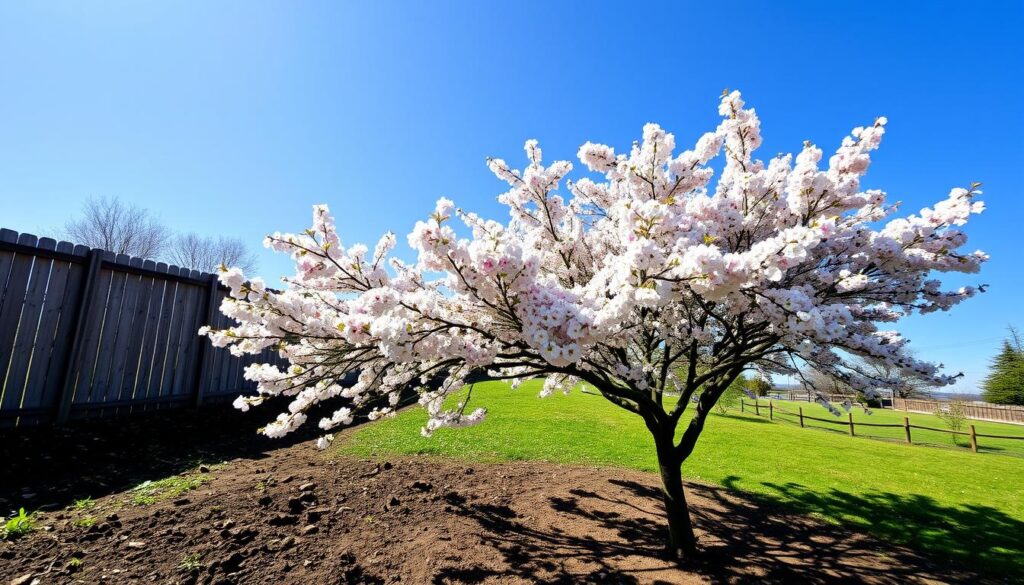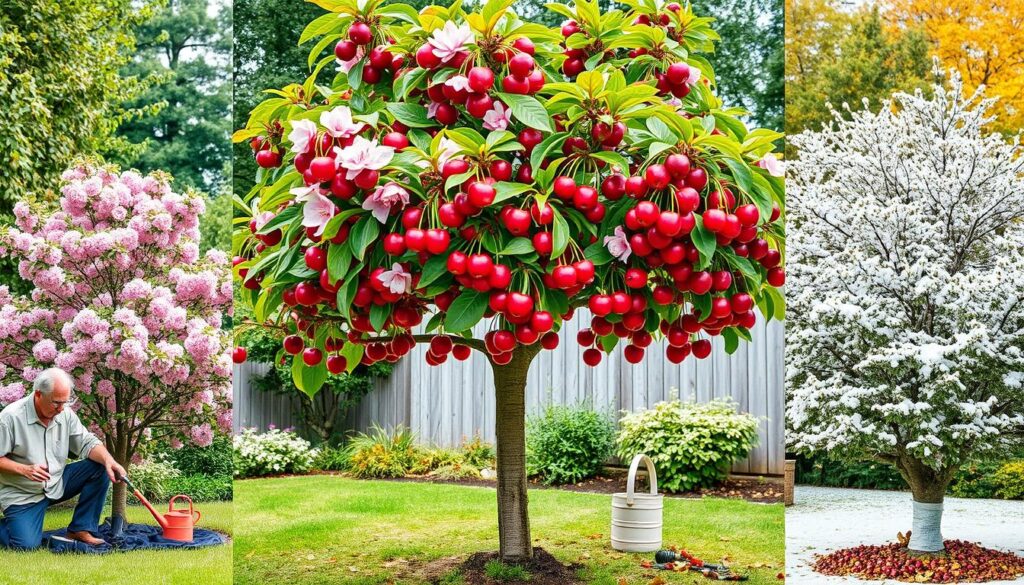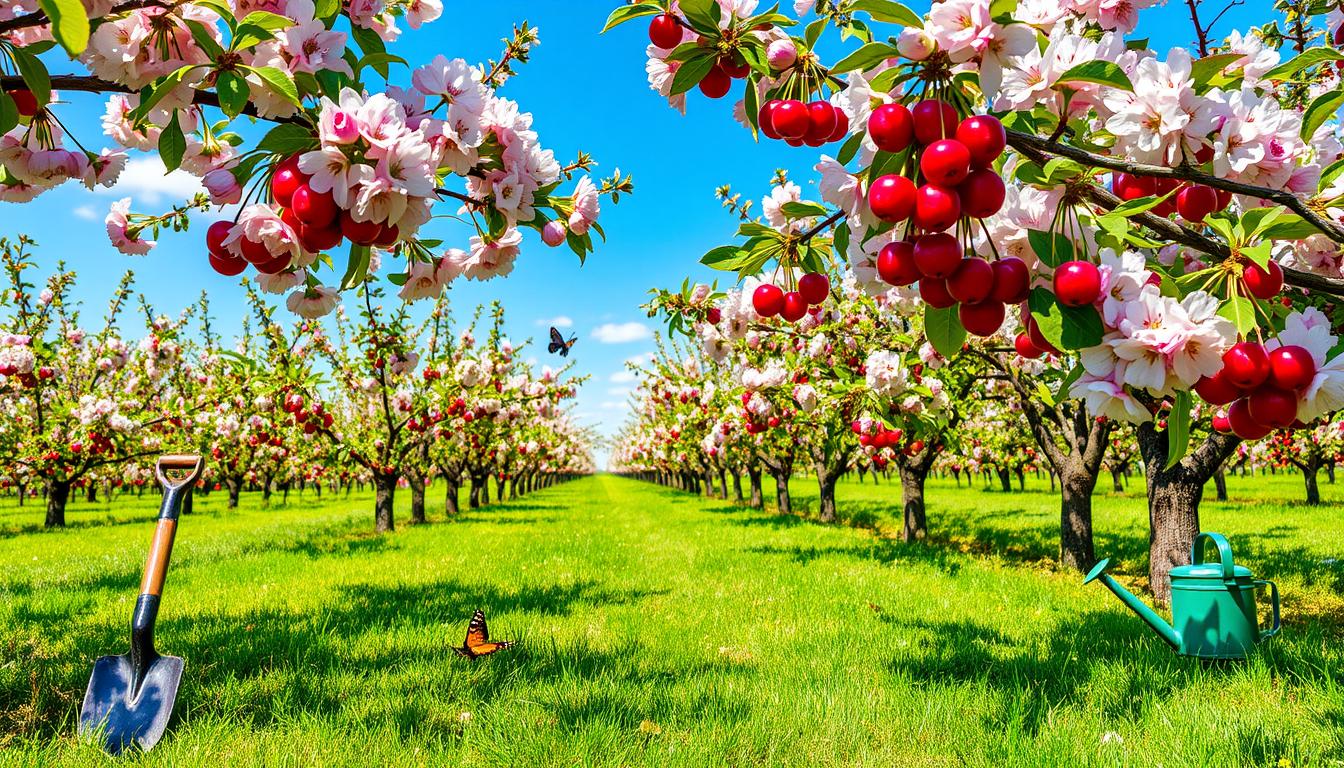Growing cherries in my backyard is a joy. It’s rewarding to grow these tasty fruits and see the beauty of cherry trees in my garden. This guide will share key tips for growing cherries at home. You’ll learn how to care for your own backyard fruit trees.
It’s not just about eating the fruit. It’s also about knowing which cherries grow well in your area. You’ll learn where to plant them and how to care for them all year. With the right knowledge, anyone can make their garden a cherry paradise.
Key Takeaways
- Discover the benefits of growing cherries in your backyard.
- Understand the different cherry varieties suitable for your climate.
- Learn about optimal planting techniques and timing.
- Gain insights into proper cherry tree care and maintenance.
- Relish the joy of harvesting homegrown cherries.
Understanding Cherry Varieties for Home Cultivation
Choosing the right cherry variety is key for growing cherries at home. Knowing the difference between sweet and sour cherries helps me pick the best ones. This depends on what I like and the local climate.
Sweet vs. Sour Cherries
Sweet cherries, like Bing and Rainier, are great to eat fresh. They taste rich and are juicy. Sour cherries, such as Montmorency, are best for cooking and baking. They add a tart flavor to many dishes.
Growing these varieties in my garden meets my cooking needs and satisfies my sweet tooth.
Recommended Varieties Based on Climate
The climate affects which cherry varieties grow well. Sweet cherry trees do best in USDA Hardiness Zones 5 to 9. Sour cherry trees thrive in Zones 4 to 8.
Many modern cherry trees are self-fertile. This means I can grow them without needing multiple trees for pollination. In cooler areas, sour cherries are a good choice. They produce fruit faster than sweet cherries.
When choosing, I also consider disease resistance and cold tolerance. For example, I suggest planting bare-root cherry trees in the dormant season. This helps them grow better. I also prepare the soil to improve their growth and fruit production.
Choosing the Right Location for Your Cherry Trees
Finding the best cherry tree location is key for your trees to grow well and give lots of fruit. It’s important to think about sunlight, air flow, soil drainage, and soil type. A good spot will help your cherry trees grow strong.
Importance of Sunlight and Air Circulation
Cherry trees need at least 6 to 8 hours of sunlight for cherry trees daily. Without enough sunlight, they won’t grow well or produce much fruit. Also, good air flow stops diseases from growing in still air. Place your trees where they get lots of sunlight and air moves freely.
Soil Drainage and Composition
Good soil drainage stops root rot, a big problem for cherry trees. Plant in soil that drains well, is fertile, and has lots of organic matter. The soil should be slightly acidic, between 6.0 to 7.0 pH. Check your soil before planting. You can do a soil test to see how it drains and what nutrients it has. For more on soil testing and getting ready, visit this page.

Essential Tips for Growing Cherries at Home
Planting cherry trees is exciting, but knowing how to prepare the soil is key. The right soil conditions are vital for your trees’ health. I focus on achieving the perfect soil pH and preparing the site for planting.
Optimal Soil pH for Cherry Trees
The soil’s pH level greatly affects cherry tree health. The best pH for cherry trees is between 5.5 and 8.0, with 6.5 being ideal. This slightly acidic level helps nutrients reach the trees, promoting growth.
It’s important to test your soil before planting. If it’s not in the right range, you might need to add lime to raise it or sulfur to lower it. Keeping the pH in this range is crucial for caring for your cherry trees.
Preparing the Planting Site
Preparing the planting site is crucial for long-term success. Here’s how to get your site ready:
- Start by clearing debris and weeds from the area.
- Dig holes that are 2 feet wide and 1.5 feet deep for the root system.
- Add organic matter like compost or well-rotted manure to improve soil fertility and structure.
- Level the ground around the holes to ensure proper drainage and prevent waterlogging.
By carefully preparing the soil, I create the best environment for growth. After planting, regular care is essential. This includes monitoring for pests and diseases that could harm my cherry trees. For more tips, check out this valuable information.
Proper Planting Techniques for Cherry Trees
Starting with the right steps is key to growing cherry trees. Knowing when to plant and following specific steps helps trees grow strong and produce fruit. Whether you’re new or have experience, these tips will guide you in planting cherry trees well.
Timing Your Planting
When to plant is very important for cherry trees. The best times are early spring or late fall. This is when the soil is moist and the weather is mild. It helps the roots grow well before the heat of summer or the cold of winter.
When planting bare-root trees, soak the roots in water for 1 to 2 hours. But don’t soak them for more than 6 hours to avoid drying out.
Steps for Planting Cherry Trees
Here are the steps to plant your cherry trees correctly:
- Select a suitable location: Cherry trees do best in sunny spots with well-drained soil. Avoid areas with heavy clay or poor drainage.
- Prepare the planting hole: Dig a hole that’s twice as wide as the root ball. This helps the roots grow. Make sure the hole is deep enough to keep the graft union 2-3 inches above the ground.
- Place the tree: Put the cherry tree in the hole, spreading the roots out evenly. Fill the hole with soil, pressing down gently to remove air pockets.
- Water thoroughly: Water the tree well after planting. This helps settle the soil around the roots. It’s crucial for the tree’s health during the first year.
- Mulch around the base: Use 2-3 inches of organic mulch, like wood bark, to keep moisture in and weeds out. In autumn, add more mulch or straw to protect the tree from cold.
- Remove any labels: Make sure to remove any nametags from the tree. They can harm the tree as it grows.
After planting, proper care is essential for cherry trees to thrive. Follow these tips and maintain your trees well for a bountiful harvest in the future.
| Aspect | Details |
|---|---|
| Ideal Soil pH for Sweet Cherries | 6.3 to 7.2 |
| Ideal Soil pH for Sour Cherries | 6.0 to 7.0 |
| Mulch Depth | 2-3 inches |
| Recommended Planting Season | Early spring or late fall |
| Root Soaking Time | 1 to 2 hours, max 6 hours |
| Graft Union Height | 2-3 inches above ground |
Cherry Tree Care: Watering and Mulching
Understanding watering cherry trees and mulching is key to their care. These practices help trees grow well and produce fruit. They also protect trees from harsh weather.
Watering Frequency and Methods
Newly planted cherry trees need lots of water at first. Water them deeply every other day for a week. Then, cut back to two to three times a week, making sure water reaches deep into the soil.
Once trees are established, they usually don’t need much water unless it’s very dry. If it rains less than an inch a week, they might need extra water. A gentle stream of water for 20 minutes helps the roots absorb what they need. During dry times, watering every seven to ten days keeps trees healthy and fruitful.
Benefits of Mulching
Mulching around cherry trees has many benefits. It keeps the soil moist, stops weeds, and keeps the soil at the right temperature. These are crucial for strong roots, especially in tough soils like heavy clay. Mulch also helps prevent water loss, especially in summer.
By watering and mulching regularly, I’ve seen big improvements in tree health and fruit production.
Cherry Tree Maintenance Throughout the Seasons
Cherry trees need careful care all year to grow well and give tasty fruit. With good seasonal care, your trees will stay healthy and give lots of fruit. Knowing how to care for them each season is key to a great harvest.
Seasonal Care Overview
Cherry tree care changes with the seasons. In spring, I prune them to help buds grow. This lets air and sun in. Summer is all about watering, especially for young trees.
Watch for signs of stress like wilting leaves. This means you can fix problems fast. In fall, I pick the fruit and get the trees ready for winter. Winter is about keeping them safe from cold and wind.
Monitoring Your Trees for Stress
Keeping an eye on your cherry trees is crucial. Spotting problems early can save your trees. Look out for:
- Wilting leaves
- Poor fruit yield
- Discoloration of foliage
- Unusual growth patterns
By always monitoring cherry trees, I can stop pests and diseases. Regular checks keep my trees healthy and fruitful.

| Season | Maintenance Tasks |
|---|---|
| Spring | Prune for air circulation, check for pests, prepare soil |
| Summer | Water regularly, monitor for pests, provide shade if needed |
| Fall | Harvest fruits, apply mulch, prepare trees for winter |
| Winter | Protect bark from rodents, establish necessary fencing |
This plan for cherry tree maintenance helps them do well all year. It leads to a big harvest every year.
The Importance of Pollination in Cherry Trees
Knowing how pollination works in cherry trees is vital for a good harvest. Good pollination leads to more fruit and healthier trees. It’s important to know the difference between self-fertile trees and those that need pollinators.
Self-Fertile vs. Pollinator Trees
Self-fertile cherry trees, like ‘Stella’, can grow fruit on their own. But many sweet cherry types, like Bing and Rainier, need bees to set fruit well. Studies show that trees with bees had 35.9% fruit set, while bees-less trees had just 2%.
How to Encourage Pollination
To help pollination, try these tips:
- Plant cherry trees close together for better pollination.
- Bring in honey bees, aiming for 10 colonies per hectare. They’re key for pollination.
- Add different plants to attract more pollinators and create a healthy garden.
- Watch out for weather issues that might hurt bees when they’re busy pollinating.
For more tips on growing cherries, check out essential tips for growing cherries at. Using these methods will make your garden more fruitful. It will also help you understand how pollination is crucial for cherry production.
Cherry Tree Pruning: Techniques and Timing
Pruning cherry trees is key for their health and fruit. The right time to prune depends on the tree type. Sour and weeping cherries are pruned in late winter. Sweet cherries do best in late summer, from August to September.
Getting the timing right is crucial. It helps the tree grow strong and produce more fruit.
When to Prune Your Cherry Tree
Young cherry trees start pruning in early spring. This is after their first buds appear. Prune older trees in early spring, after harvest, to remove bad branches.
Using the right tools is important. Bypass pruners and a pruning saw are best. Clean these tools to avoid spreading disease.
Pruning Techniques for Maximum Yield
Pruning techniques that help air flow and growth are best. Young trees should have an open shape. Older trees need a more structured shape to keep the canopy open.
Removing suckers and dead branches yearly is important. Neglecting pruning can harm fruit production and make trees more vulnerable to disease. For more tips, I look at pruning guides. This way, my cherry trees look great and produce more fruit every year.



Leave a Reply